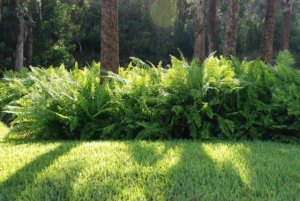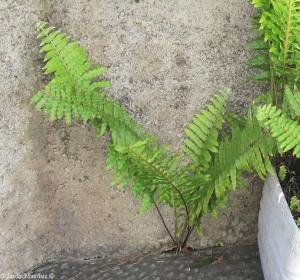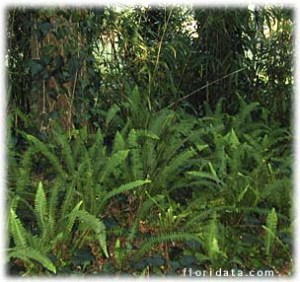What exactly does the “Boston” fern have to do with The Hub? (And does anyone call Boston ‘the hub’ anymore?) Nephrolepis exaltata is a subtropical plant, occurring naturally as far north as south Florida and throughout the West Indies, Mexico, Central and South America, Polynesia and Africa. It is classified as an invasive alien in South Africa, where by law it is eradicated on sight.

The wild type is often called a sword fern, but that common name is also given to several species of fern in the genus Polystichum. It is so named because its fronds stick nearly straight up in the air to the height of three feet. In the wild it forms thickets throughout south Florida. Nephrolepis cordifolia is invasive in south Florida, forming impenetrable thickets that have to be removed to permit native species to grow.
As a house plant the cultivars are ubiquitous. The pinnae on the fronds are alternate (some ferns are opposite), and in the wild type the sori (which hold the spores) . The gracefully arching fronds that make this fern so popular in hanging baskets and on elevated shelves are the result of a mutation that has been preserved by reproducing the plant through division. The name of the variety is ‘Bostoniensis.’
The “-ensis” suffix is common in the trivial names of plants because it means “of or from <a place>.” Sometimes the reference can be a little esoteric, as in the case of the York groundsel, a species of ragwort, Senecio eboracensis. Eboracum is the Roman name for the modern city of York in northern England. The self-pollinating ragwort grows only between a railway and a parking lot in that city.
The origin of the varietal name of N. exaltata is not definitely known. One story has it that the mutation was discovered in 1894 in a shipment of plants that was sent from Philadelphia to Boston. American botanist David Fairchild claimed that the cultivar was named by a Florida nurseryman who developed it and sent specimens to a friend in Boston.
As popular as they are, Boston ferns are non-trivial to grow, although nearly all the internet plant sites will tell you it is easy to maintain. They are in fact easier to grow indoors compared to most other ferns, most of which need to be kept in terrariums.
Although they are known to be incredibly efficient at improving indoor air (turning carbon dioxide into oxygen through photosynthesis), they are also very sensitive to indoor air pollutants, such as coal and wood smoke. They also dislike drafts.

This latter quality is one particularly true of the ‘Bostoniensis’ cultivar. The species is more tolerant of the cold and was a popular Victorian house plant. The Victorians famously believed in the improving quality of fresh air and routinely opened windows in cold weather to air out their homes. They actually went so far as to make sure no vegetation grew next to the houses that might impede the flow of air.
These ferns need to be kept watered because in addition to producing oxygen they also pump water vapor into the air. The roots should never be allowed to dry out. It is necessary to mist the fronds if the humidity in your house falls below 80 percent. If grown inside it requires bright but filtered light.

If grown in a pot, it should be in standard peat-based mixture. Otherwise mix half soil-based mixture with half leaf mold. When the plant’s roots fill the pot, move it to another pot only one size larger. It will just keep growing, so when it gets to the maximum size that you want to tolerate, just trim off the outermost roots and put it back in the pot.
It can be grown outside in USDA Plant Hardiness Zones 8B through 11, roughly South Carolina to Florida on the East Coast, where natural humidity would be adequate. Although the plant will die back during the winter in the northern part of this range, it will sprout new foliage in the spring. The species (without the arching fronds) reaches two to three feet in height and spreads by runners, so it forms a thick monocultural patch wherever you plant it and needs to be thinned periodically.
